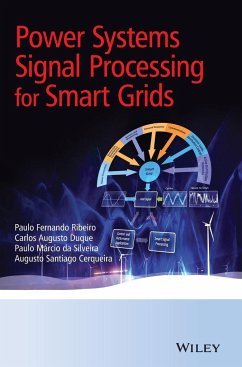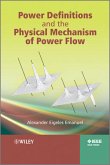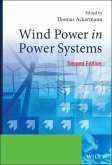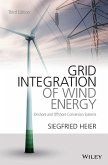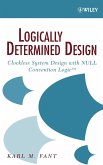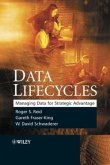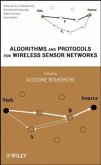Paulo Fernando Ribeiro, Carlos Augusto Duque, Paulo Márcio Ribeiro, Augusto Santiago Cerqueira
Power Systems Signal Processing for Smart Grids
By Ribeiro, Paulo F.; Cerqueira, Augusto Santiago; Ribeiro, Moises Vidal; Silveira, Paulo Márcio da; Duque, Carlos Augusto
Paulo Fernando Ribeiro, Carlos Augusto Duque, Paulo Márcio Ribeiro, Augusto Santiago Cerqueira
Power Systems Signal Processing for Smart Grids
By Ribeiro, Paulo F.; Cerqueira, Augusto Santiago; Ribeiro, Moises Vidal; Silveira, Paulo Márcio da; Duque, Carlos Augusto
- Gebundenes Buch
- Merkliste
- Auf die Merkliste
- Bewerten Bewerten
- Teilen
- Produkt teilen
- Produkterinnerung
- Produkterinnerung
With special relation to smart grids, this book provides clear and comprehensive explanation of how Digital Signal Processing (DSP) and Computational Intelligence (CI) techniques can be applied to solve problems in the power system.
Its unique coverage bridges the gap between DSP, electrical power and energy engineering systems, showing many different techniques applied to typical and expected system conditions with practical power system examples.
Surveying all recent advances on DSP for power systems, this book enables engineers and researchers to understand the current state of the…mehr
Andere Kunden interessierten sich auch für
![Power Definitions and the Physical Mechanism of Power Flow Power Definitions and the Physical Mechanism of Power Flow]() Alexander Eigeles EmanuelPower Definitions and the Physical Mechanism of Power Flow121,99 €
Alexander Eigeles EmanuelPower Definitions and the Physical Mechanism of Power Flow121,99 €![Wind Power in Power Systems Wind Power in Power Systems]() Wind Power in Power Systems200,99 €
Wind Power in Power Systems200,99 €![Grid Integration of Wind Energy Grid Integration of Wind Energy]() Siegfried HeierGrid Integration of Wind Energy152,99 €
Siegfried HeierGrid Integration of Wind Energy152,99 €![Logically Determined Design Logically Determined Design]() K. FantLogically Determined Design188,99 €
K. FantLogically Determined Design188,99 €![Algorithms and Protocols for Wireless and Mobile AD Hoc Networks Algorithms and Protocols for Wireless and Mobile AD Hoc Networks]() Algorithms and Protocols for Wireless and Mobile AD Hoc Networks184,99 €
Algorithms and Protocols for Wireless and Mobile AD Hoc Networks184,99 €![Data Lifecycles Data Lifecycles]() Roger ReidData Lifecycles136,99 €
Roger ReidData Lifecycles136,99 €![Algorithms and Protocols for Wireless Sensor Networks Algorithms and Protocols for Wireless Sensor Networks]() Algorithms and Protocols for Wireless Sensor Networks184,99 €
Algorithms and Protocols for Wireless Sensor Networks184,99 €-
-
-
With special relation to smart grids, this book provides clear and comprehensive explanation of how Digital Signal Processing (DSP) and Computational Intelligence (CI) techniques can be applied to solve problems in the power system.
Its unique coverage bridges the gap between DSP, electrical power and energy engineering systems, showing many different techniques applied to typical and expected system conditions with practical power system examples.
Surveying all recent advances on DSP for power systems, this book enables engineers and researchers to understand the current state of the art and to develop new tools. It presents:
an overview on the power system and electric signals, with description of the basic concepts of DSP commonly found in power system problems
the application of several signal processing tools to problems, looking at power signal estimation and decomposition, pattern recognition techniques, detection of the power system signal variations
description of DSP in relation to measurements, power quality, monitoring, protection and control, and wide area monitoring
a companion website with real signal data, several Matlab codes with examples, DSP scripts and samples of signals for further processing, understanding and analysis
Practicing power systems engineers and utility engineers will find this book invaluable, as will researchers of electrical power and energy systems, postgraduate electrical engineering students, and staff at utility companies.
Hinweis: Dieser Artikel kann nur an eine deutsche Lieferadresse ausgeliefert werden.
Its unique coverage bridges the gap between DSP, electrical power and energy engineering systems, showing many different techniques applied to typical and expected system conditions with practical power system examples.
Surveying all recent advances on DSP for power systems, this book enables engineers and researchers to understand the current state of the art and to develop new tools. It presents:
an overview on the power system and electric signals, with description of the basic concepts of DSP commonly found in power system problems
the application of several signal processing tools to problems, looking at power signal estimation and decomposition, pattern recognition techniques, detection of the power system signal variations
description of DSP in relation to measurements, power quality, monitoring, protection and control, and wide area monitoring
a companion website with real signal data, several Matlab codes with examples, DSP scripts and samples of signals for further processing, understanding and analysis
Practicing power systems engineers and utility engineers will find this book invaluable, as will researchers of electrical power and energy systems, postgraduate electrical engineering students, and staff at utility companies.
Hinweis: Dieser Artikel kann nur an eine deutsche Lieferadresse ausgeliefert werden.
Produktdetails
- Produktdetails
- Wiley - IEEE .
- Verlag: Wiley & Sons
- 1. Auflage
- Seitenzahl: 448
- Erscheinungstermin: Dezember 2013
- Englisch
- Abmessung: 250mm x 175mm x 28mm
- Gewicht: 939g
- ISBN-13: 9781119991502
- ISBN-10: 1119991501
- Artikelnr.: 37305172
- Herstellerkennzeichnung
- Libri GmbH
- Europaallee 1
- 36244 Bad Hersfeld
- gpsr@libri.de
- Wiley - IEEE .
- Verlag: Wiley & Sons
- 1. Auflage
- Seitenzahl: 448
- Erscheinungstermin: Dezember 2013
- Englisch
- Abmessung: 250mm x 175mm x 28mm
- Gewicht: 939g
- ISBN-13: 9781119991502
- ISBN-10: 1119991501
- Artikelnr.: 37305172
- Herstellerkennzeichnung
- Libri GmbH
- Europaallee 1
- 36244 Bad Hersfeld
- gpsr@libri.de
Professor Paulo F. Ribeiro, Calvin College, USA Professor Ribeiro is professor of Engineering at Calvin College, Michigan. He has been involved with the application of advanced signal processing, applied to power quality and power systems in general, for the past fifteen years. For the past six years he has chaired the IEEE Task Force on Probabilistic Aspects of Harmonics. In 1994 he proposed the use of wallets to power quality applications; this has been followed by many people and has generated much research, several Masters and a PhD Thesis. Dr. Ribeiro is active in the IEEE, CIGRE and IEC working groups on power quality, and is a Registered Professional Engineer in the State of Iowa.
About the Authors xiii
Preface xv
AccompanyingWebsite xxi
Acknowledgments xxiii
1 Introduction 1
1.1 Introduction 1
1.2 The Future Grid 2
1.3 Motivation and Objectives 3
1.4 Signal Processing Framework 4
1.5 Conclusions 8
References 10
2 Power Systems and Signal Processing 11
2.1 Introduction 11
2.2 Dynamic Overvoltage 12
2.2.1 Sustained Overvoltage 12
2.2.2 Lightning Surge 13
2.2.3 Switching Surges 15
2.2.4 Switching of Capacitor Banks 17
2.3 Fault Current and DC Component 21
2.4 Voltage Sags and Voltage Swells 25
2.5 Voltage Fluctuations 27
2.6 Voltage and Current Imbalance 29
2.7 Harmonics and Interharmonics 29
2.8 Inrush Current in Power Transformers 42
2.9 Over-Excitation of Transformers 45
2.10 Transients in Instrument Transformers 47
2.10.1 Current Transformer (CT) Saturation (Protection Services) 47
2.10.2 Capacitive Voltage Transformer (CVT) Transients 54
2.11 Ferroresonance 55
2.12 Frequency Variation 56
2.13 Other Kinds of Phenomena and their Signals 56
2.14 Conclusions 57
References 58
3 Transducers and Acquisition Systems 59
3.1 Introduction 59
3.2 Voltage Transformers (VTs) 60
3.3 Capacitor Voltage Transformers 64
3.4 Current Transformers 67
3.5 Non-Conventional Transducers 71
3.5.1 Resistive Voltage Divider 71
3.5.2 Optical Voltage Transducer 72
3.5.3 Rogowski Coil 73
3.5.4 Optical Current Transducer 74
3.6 Analog-to-Digital Conversion Processing 75
3.6.1 Supervision and Control 78
3.6.2 Protection 79
3.6.3 Power Quality 79
3.7 Mathematical Model for Noise 80
3.8 Sampling and the Anti-Aliasing Filtering 81
3.9 Sampling Rate for Power System Application 84
3.10 Smart-Grid Context and Conclusions 84
References 85
4 Discrete Transforms 87
4.1 Introduction 87
4.2 Representation of Periodic Signals using Fourier Series 87
4.2.1 Computation of Series Coefficients 90
4.2.2 The Exponential Fourier Series 92
4.2.3 Relationship between the Exponential and Trigonometric oefficients 93
4.2.4 Harmonics in Power Systems 95
4.2.5 Proprieties of a Fourier Series 97
4.3 A Fourier Transform 98
4.3.1 Introduction and Examples 98
4.3.2 Fourier Transform Properties 103
4.4 The Sampling Theorem 104
4.5 The Discrete-Time Fourier Transform 108
4.5.1 DTFT Pairs 109
4.5.2 Properties of DTFT 110
4.6 The Discrete Fourier Transform (DFT) 110
4.6.1 Sampling the Fourier Transform 116
4.6.2 Discrete Fourier Transform Theorems 116
4.7 Recursive DFT 117
4.8 Filtering Interpretation of DFT 120
4.8.1 Frequency Response of DFT Filter 123
4.8.2 Asynchronous Sampling 124
4.9 The z-Transform 126
4.9.1 Rational z-Transforms 128
4.9.2 Stability of Rational Transfer Function 131
4.9.3 Some Common z-Transform Pairs 131
4.9.4 z-Transform Properties 133
4.10 Conclusions 133
References 133
5 Basic Power Systems Signal Processing 135
5.1 Introduction 135
5.2 Linear and Time-Invariant Systems 135
5.2.1 Frequency Response of LTI System 138
5.2.2 Linear Phase FIR Filter 140
5.3 Basic Digital System and Power System Applications 142
5.3.1 Moving Average Systems: Application 142
5.3.2 RMS Estimation 144
5.3.3 Trapezoidal Integration and Bilinear Transform 146
5.3.4 Differentiators Filters: Application 148
5.3.5 Simple Differentiator 151
5.4 Parametric Filters in Power System Applications 153
5.4.1 Filter Specification 154
5.4.2 First-Order Low-Pass Filter 155
5.4.3 First-Order High-Pass Filter 155
5.4.4 Bandstop IIR Digital Filter (The Notch Filter) 156
5.4.5 Total Harmonic Distortion in Time Domain (THD) 159
5.4.6 Signal Decomposition using a Notch Filter 161
5.5 Parametric Notch FIR Filters 161
5.6 Filter Design using MATLAB1 (FIR and IIR) 163
5.7 Sine and Cosine FIR Filters 163
5.8 Smart-Grid Context and Conclusions 165
References 166
6 Multirate Systems and Sampling Alterations 167
6.1 Introduction 167
6.2 Basic Blocks for Sampling Rate Alteration 167
6.2.1 Frequency Domain Interpretation 168
6.2.2 Up-Sampling in Frequency Domain 169
6.2.3 Down-Sampling in Frequency Domain 169
6.3 The Interpolator 170
6.3.1 The Input-Output Relation for the Interpolator 172
6.3.2 Multirate System as a Time-Varying System and Nobles Identities 172
6.4 The Decimator 174
6.4.1 Introduction 174
6.4.2 The Input-Output Relation for the Decimator 174
6.5 Fractional Sampling Rate Alteration 175
6.5.1 Resampling Using MATLAB1 175
6.6 Real-Time Sampling Rate Alteration 176
6.6.1 Spline Interpolation 177
6.6.2 Cubic B-Spline Interpolation 180
6.7 Conclusions 184
References 184
7 Estimation of Electrical Parameters 185
7.1 Introduction 185
7.2 Estimation Theory 185
7.3 Least-Squares Estimator 187
7.3.1 Linear Least-Squares 188
7.4 Frequency Estimation 191
7.4.1 Frequency Estimation Based on Zero Crossing (IEC61000-4-30) 192
7.4.2 Short-Term Frequency Estimator Based on Zero Crossing 195
7.4.3 Frequency Estimation Based on Phasor Rotation 198
7.4.4 Varying the DFT Window Size 200
7.4.5 Frequency Estimation Based on LSE 201
7.4.6 IIR Notch Filter 203
7.4.7 Small Coefficient and/or Small Arithmetic Errors 203
7.5 Phasor Estimation 205
7.5.1 Introduction 205
7.5.2 The PLL Structure 207
7.5.3 Kalman Filter Estimation 209
7.5.4 Example of Phasor Estimation using Kalman Filter 211
7.6 Phasor Estimation in Presence of DC Component 212
7.6.1 Mathematical Model for the Signal in Presence of DC Decaying 213
7.6.2 Mimic Method 214
7.6.3 Least-Squares Estimator (LSE) 215
7.6.4 Improved DTFT Estimation Method 216
7.7 Conclusions 224
References 224
8 Spectral Estimation 227
8.1 Introduction 227
8.2 Spectrum Estimation 227
8.2.1 Understanding Spectral Leakage 229
8.2.2 Interpolation in Frequency Domain: Single-Tone Signal 232
8.3 Windows 236
8.3.1 Frequency-Domain Windowing 236
8.4 Interpolation in Frequency Domain: Multitone Signal 240
8.5 Interharmonics 243
8.5.1 Typical Interhamonic Sources 246
8.5.2 The IEC Standard 61000-4-7 247
8.6 Interharmonic Detection and Estimation Based on IEC Standard 250
8.7 Parametric Methods for Spectral Estimation 254
8.7.1 Prony Method 254
8.7.2 Signal and Noise Subspace Techniques 262
8.8 Conclusions 269
References 270
9 Time-Frequency Signal Decomposition 271
9.1 Introduction 271
9.2 Short-Time Fourier Transform 274
9.2.1 Filter Banks Interpretation 274
9.2.2 Choosing the Window: Uncertainty Principle 276
9.2.3 The Time-Frequency Grid 279
9.3 Sliding Window DFT 280
9.3.1 Sliding Window DFT: Modified Structure 282
9.3.2 Power System Application 282
9.4 Filter Banks 284
9.4.1 Two-Channel Quadrature-Mirror Filter Bank 288
9.4.2 An Alias-Free Realization 290
9.4.3 A PR Condition 290
9.4.4 Finding the Filters from P(z) 292
9.4.5 General Filter Banks 294
9.4.6 Harmonic Decomposition Using PR Filter Banks 295
9.4.7 The Sampling Frequency 298
9.4.8 Extracting Even Harmonics 298
9.4.9 The Synthesis Filter Banks 300
9.5 Wavelet 300
9.5.1 Continuous Wavelet Transform 301
9.5.2 The Inverse Continuous Wavelet Transform 305
9.5.3 Discrete Wavelet Transform (DWT) 305
9.5.4 The Inverse Discrete Wavelet Transform 308
9.5.5 Discrete-Time Wavelet Transform 308
9.5.6 Design Issues in Wavelet Transform 313
9.5.7 Power System Application of Wavelet Transform 316
9.5.8 Real-Time Wavelet Implementation 318
9.6 Conclusions 319
References 319
10 Pattern Recognition 321
10.1 Introduction 321
10.2 The Basics of Pattern Recognition 322
10.2.1 Datasets 323
10.2.2 Supervised and Unsupervised Learning 323
10.3 Bayes Decision Theory 323
10.4 Feature Extraction on the Power Signal 324
10.4.1 Effective Value (RMS) 324
10.4.2 Discrete Fourier Transform 325
10.4.3 Wavelet Transform 325
10.4.4 Cumulants of Higher-Order Statistics 325
10.4.5 Principal Component Analysis 326
10.4.6 Normalization 327
10.4.7 Feature Selection 328
10.5 Classifiers 329
10.5.1 Minimum Distance Classifiers 329
10.5.2 Nearest Neighbor Classifier 329
10.5.3 The Perceptron 330
10.5.4 Least-Squares Methods 334
10.5.5 Multilayer Perceptron 337
10.5.6 Support Vector Machines 342
10.6 System Evaluation 348
10.6.1 Estimation of the Classification Error Probability 349
10.6.2 Limited-Size Dataset 350
10.7 Pattern Recognition Examples in Power Systems 350
10.7.1 Power Quality Disturbance Classification 350
10.7.2 Load Forecasting in Electric Power Systems 351
10.7.3 Power System Security Assessment 353
10.8 Conclusions 353
References 353
11 Detection 355
11.1 Introduction 355
11.2 Why Signal Detection for Electric Power Systems? 355
11.3 Detection Theory Basics 356
11.3.1 Detection on the Bayesian Framework 356
11.3.2 Newman-Pearson Criterion 357
11.3.3 Receiving Operating Characteristics 358
11.3.4 Deterministic Signal Detection in White Gaussian Noise 358
11.3.5 Deterministic Signals with Unknown Parameters 363
11.4 Detection of Disturbances in Power Systems 368
11.4.1 The Power System Signal 368
11.4.2 Optimal Detection 369
11.4.3 Feature Extraction 370
11.4.4 Commonly Used Detection Algorithms 370
11.5 Examples 371
11.5.1 Transmission Lines Protection 371
11.5.2 Detection Algorithms Based on Estimation 373
11.5.3 Saturation Detection in Current Transformers 377
11.6 Smart-Grid Context and Conclusions 380
References 381
12 Wavelets Applied to Power Fluctuations 383
12.1 Introduction 383
12.2 Basic Theory 384
12.3 Application of Wavelets for Time-Varying Generation and Load Profiles
385
12.3.1 Fluctuation Analyses with FFT 385
12.3.2 Methodology 386
12.3.3 Load Fluctuations 387
12.3.4 Wind Farm Generation Fluctuations 389
12.3.5 Smart Microgrid 390
12.4 Conclusions 392
References 392
13 Time-Varying Harmonic and Asymmetry Unbalances 395
13.1 Introduction 395
13.2 Sequence Component Computation 396
13.3 Time-Varying Unbalance and Harmonic Frequencies 397
13.4 Computation of Time-Varying Unbalances and Asymmetries at Harmonic
Frequencies 398
13.5 Examples 401
13.5.1 Inrush Current 401
13.5.2 Voltage Sag 404
13.5.3 Unbalance in Converters 407
13.6 Conclusions 410
References 411
Index 413
Preface xv
AccompanyingWebsite xxi
Acknowledgments xxiii
1 Introduction 1
1.1 Introduction 1
1.2 The Future Grid 2
1.3 Motivation and Objectives 3
1.4 Signal Processing Framework 4
1.5 Conclusions 8
References 10
2 Power Systems and Signal Processing 11
2.1 Introduction 11
2.2 Dynamic Overvoltage 12
2.2.1 Sustained Overvoltage 12
2.2.2 Lightning Surge 13
2.2.3 Switching Surges 15
2.2.4 Switching of Capacitor Banks 17
2.3 Fault Current and DC Component 21
2.4 Voltage Sags and Voltage Swells 25
2.5 Voltage Fluctuations 27
2.6 Voltage and Current Imbalance 29
2.7 Harmonics and Interharmonics 29
2.8 Inrush Current in Power Transformers 42
2.9 Over-Excitation of Transformers 45
2.10 Transients in Instrument Transformers 47
2.10.1 Current Transformer (CT) Saturation (Protection Services) 47
2.10.2 Capacitive Voltage Transformer (CVT) Transients 54
2.11 Ferroresonance 55
2.12 Frequency Variation 56
2.13 Other Kinds of Phenomena and their Signals 56
2.14 Conclusions 57
References 58
3 Transducers and Acquisition Systems 59
3.1 Introduction 59
3.2 Voltage Transformers (VTs) 60
3.3 Capacitor Voltage Transformers 64
3.4 Current Transformers 67
3.5 Non-Conventional Transducers 71
3.5.1 Resistive Voltage Divider 71
3.5.2 Optical Voltage Transducer 72
3.5.3 Rogowski Coil 73
3.5.4 Optical Current Transducer 74
3.6 Analog-to-Digital Conversion Processing 75
3.6.1 Supervision and Control 78
3.6.2 Protection 79
3.6.3 Power Quality 79
3.7 Mathematical Model for Noise 80
3.8 Sampling and the Anti-Aliasing Filtering 81
3.9 Sampling Rate for Power System Application 84
3.10 Smart-Grid Context and Conclusions 84
References 85
4 Discrete Transforms 87
4.1 Introduction 87
4.2 Representation of Periodic Signals using Fourier Series 87
4.2.1 Computation of Series Coefficients 90
4.2.2 The Exponential Fourier Series 92
4.2.3 Relationship between the Exponential and Trigonometric oefficients 93
4.2.4 Harmonics in Power Systems 95
4.2.5 Proprieties of a Fourier Series 97
4.3 A Fourier Transform 98
4.3.1 Introduction and Examples 98
4.3.2 Fourier Transform Properties 103
4.4 The Sampling Theorem 104
4.5 The Discrete-Time Fourier Transform 108
4.5.1 DTFT Pairs 109
4.5.2 Properties of DTFT 110
4.6 The Discrete Fourier Transform (DFT) 110
4.6.1 Sampling the Fourier Transform 116
4.6.2 Discrete Fourier Transform Theorems 116
4.7 Recursive DFT 117
4.8 Filtering Interpretation of DFT 120
4.8.1 Frequency Response of DFT Filter 123
4.8.2 Asynchronous Sampling 124
4.9 The z-Transform 126
4.9.1 Rational z-Transforms 128
4.9.2 Stability of Rational Transfer Function 131
4.9.3 Some Common z-Transform Pairs 131
4.9.4 z-Transform Properties 133
4.10 Conclusions 133
References 133
5 Basic Power Systems Signal Processing 135
5.1 Introduction 135
5.2 Linear and Time-Invariant Systems 135
5.2.1 Frequency Response of LTI System 138
5.2.2 Linear Phase FIR Filter 140
5.3 Basic Digital System and Power System Applications 142
5.3.1 Moving Average Systems: Application 142
5.3.2 RMS Estimation 144
5.3.3 Trapezoidal Integration and Bilinear Transform 146
5.3.4 Differentiators Filters: Application 148
5.3.5 Simple Differentiator 151
5.4 Parametric Filters in Power System Applications 153
5.4.1 Filter Specification 154
5.4.2 First-Order Low-Pass Filter 155
5.4.3 First-Order High-Pass Filter 155
5.4.4 Bandstop IIR Digital Filter (The Notch Filter) 156
5.4.5 Total Harmonic Distortion in Time Domain (THD) 159
5.4.6 Signal Decomposition using a Notch Filter 161
5.5 Parametric Notch FIR Filters 161
5.6 Filter Design using MATLAB1 (FIR and IIR) 163
5.7 Sine and Cosine FIR Filters 163
5.8 Smart-Grid Context and Conclusions 165
References 166
6 Multirate Systems and Sampling Alterations 167
6.1 Introduction 167
6.2 Basic Blocks for Sampling Rate Alteration 167
6.2.1 Frequency Domain Interpretation 168
6.2.2 Up-Sampling in Frequency Domain 169
6.2.3 Down-Sampling in Frequency Domain 169
6.3 The Interpolator 170
6.3.1 The Input-Output Relation for the Interpolator 172
6.3.2 Multirate System as a Time-Varying System and Nobles Identities 172
6.4 The Decimator 174
6.4.1 Introduction 174
6.4.2 The Input-Output Relation for the Decimator 174
6.5 Fractional Sampling Rate Alteration 175
6.5.1 Resampling Using MATLAB1 175
6.6 Real-Time Sampling Rate Alteration 176
6.6.1 Spline Interpolation 177
6.6.2 Cubic B-Spline Interpolation 180
6.7 Conclusions 184
References 184
7 Estimation of Electrical Parameters 185
7.1 Introduction 185
7.2 Estimation Theory 185
7.3 Least-Squares Estimator 187
7.3.1 Linear Least-Squares 188
7.4 Frequency Estimation 191
7.4.1 Frequency Estimation Based on Zero Crossing (IEC61000-4-30) 192
7.4.2 Short-Term Frequency Estimator Based on Zero Crossing 195
7.4.3 Frequency Estimation Based on Phasor Rotation 198
7.4.4 Varying the DFT Window Size 200
7.4.5 Frequency Estimation Based on LSE 201
7.4.6 IIR Notch Filter 203
7.4.7 Small Coefficient and/or Small Arithmetic Errors 203
7.5 Phasor Estimation 205
7.5.1 Introduction 205
7.5.2 The PLL Structure 207
7.5.3 Kalman Filter Estimation 209
7.5.4 Example of Phasor Estimation using Kalman Filter 211
7.6 Phasor Estimation in Presence of DC Component 212
7.6.1 Mathematical Model for the Signal in Presence of DC Decaying 213
7.6.2 Mimic Method 214
7.6.3 Least-Squares Estimator (LSE) 215
7.6.4 Improved DTFT Estimation Method 216
7.7 Conclusions 224
References 224
8 Spectral Estimation 227
8.1 Introduction 227
8.2 Spectrum Estimation 227
8.2.1 Understanding Spectral Leakage 229
8.2.2 Interpolation in Frequency Domain: Single-Tone Signal 232
8.3 Windows 236
8.3.1 Frequency-Domain Windowing 236
8.4 Interpolation in Frequency Domain: Multitone Signal 240
8.5 Interharmonics 243
8.5.1 Typical Interhamonic Sources 246
8.5.2 The IEC Standard 61000-4-7 247
8.6 Interharmonic Detection and Estimation Based on IEC Standard 250
8.7 Parametric Methods for Spectral Estimation 254
8.7.1 Prony Method 254
8.7.2 Signal and Noise Subspace Techniques 262
8.8 Conclusions 269
References 270
9 Time-Frequency Signal Decomposition 271
9.1 Introduction 271
9.2 Short-Time Fourier Transform 274
9.2.1 Filter Banks Interpretation 274
9.2.2 Choosing the Window: Uncertainty Principle 276
9.2.3 The Time-Frequency Grid 279
9.3 Sliding Window DFT 280
9.3.1 Sliding Window DFT: Modified Structure 282
9.3.2 Power System Application 282
9.4 Filter Banks 284
9.4.1 Two-Channel Quadrature-Mirror Filter Bank 288
9.4.2 An Alias-Free Realization 290
9.4.3 A PR Condition 290
9.4.4 Finding the Filters from P(z) 292
9.4.5 General Filter Banks 294
9.4.6 Harmonic Decomposition Using PR Filter Banks 295
9.4.7 The Sampling Frequency 298
9.4.8 Extracting Even Harmonics 298
9.4.9 The Synthesis Filter Banks 300
9.5 Wavelet 300
9.5.1 Continuous Wavelet Transform 301
9.5.2 The Inverse Continuous Wavelet Transform 305
9.5.3 Discrete Wavelet Transform (DWT) 305
9.5.4 The Inverse Discrete Wavelet Transform 308
9.5.5 Discrete-Time Wavelet Transform 308
9.5.6 Design Issues in Wavelet Transform 313
9.5.7 Power System Application of Wavelet Transform 316
9.5.8 Real-Time Wavelet Implementation 318
9.6 Conclusions 319
References 319
10 Pattern Recognition 321
10.1 Introduction 321
10.2 The Basics of Pattern Recognition 322
10.2.1 Datasets 323
10.2.2 Supervised and Unsupervised Learning 323
10.3 Bayes Decision Theory 323
10.4 Feature Extraction on the Power Signal 324
10.4.1 Effective Value (RMS) 324
10.4.2 Discrete Fourier Transform 325
10.4.3 Wavelet Transform 325
10.4.4 Cumulants of Higher-Order Statistics 325
10.4.5 Principal Component Analysis 326
10.4.6 Normalization 327
10.4.7 Feature Selection 328
10.5 Classifiers 329
10.5.1 Minimum Distance Classifiers 329
10.5.2 Nearest Neighbor Classifier 329
10.5.3 The Perceptron 330
10.5.4 Least-Squares Methods 334
10.5.5 Multilayer Perceptron 337
10.5.6 Support Vector Machines 342
10.6 System Evaluation 348
10.6.1 Estimation of the Classification Error Probability 349
10.6.2 Limited-Size Dataset 350
10.7 Pattern Recognition Examples in Power Systems 350
10.7.1 Power Quality Disturbance Classification 350
10.7.2 Load Forecasting in Electric Power Systems 351
10.7.3 Power System Security Assessment 353
10.8 Conclusions 353
References 353
11 Detection 355
11.1 Introduction 355
11.2 Why Signal Detection for Electric Power Systems? 355
11.3 Detection Theory Basics 356
11.3.1 Detection on the Bayesian Framework 356
11.3.2 Newman-Pearson Criterion 357
11.3.3 Receiving Operating Characteristics 358
11.3.4 Deterministic Signal Detection in White Gaussian Noise 358
11.3.5 Deterministic Signals with Unknown Parameters 363
11.4 Detection of Disturbances in Power Systems 368
11.4.1 The Power System Signal 368
11.4.2 Optimal Detection 369
11.4.3 Feature Extraction 370
11.4.4 Commonly Used Detection Algorithms 370
11.5 Examples 371
11.5.1 Transmission Lines Protection 371
11.5.2 Detection Algorithms Based on Estimation 373
11.5.3 Saturation Detection in Current Transformers 377
11.6 Smart-Grid Context and Conclusions 380
References 381
12 Wavelets Applied to Power Fluctuations 383
12.1 Introduction 383
12.2 Basic Theory 384
12.3 Application of Wavelets for Time-Varying Generation and Load Profiles
385
12.3.1 Fluctuation Analyses with FFT 385
12.3.2 Methodology 386
12.3.3 Load Fluctuations 387
12.3.4 Wind Farm Generation Fluctuations 389
12.3.5 Smart Microgrid 390
12.4 Conclusions 392
References 392
13 Time-Varying Harmonic and Asymmetry Unbalances 395
13.1 Introduction 395
13.2 Sequence Component Computation 396
13.3 Time-Varying Unbalance and Harmonic Frequencies 397
13.4 Computation of Time-Varying Unbalances and Asymmetries at Harmonic
Frequencies 398
13.5 Examples 401
13.5.1 Inrush Current 401
13.5.2 Voltage Sag 404
13.5.3 Unbalance in Converters 407
13.6 Conclusions 410
References 411
Index 413
About the Authors xiii
Preface xv
AccompanyingWebsite xxi
Acknowledgments xxiii
1 Introduction 1
1.1 Introduction 1
1.2 The Future Grid 2
1.3 Motivation and Objectives 3
1.4 Signal Processing Framework 4
1.5 Conclusions 8
References 10
2 Power Systems and Signal Processing 11
2.1 Introduction 11
2.2 Dynamic Overvoltage 12
2.2.1 Sustained Overvoltage 12
2.2.2 Lightning Surge 13
2.2.3 Switching Surges 15
2.2.4 Switching of Capacitor Banks 17
2.3 Fault Current and DC Component 21
2.4 Voltage Sags and Voltage Swells 25
2.5 Voltage Fluctuations 27
2.6 Voltage and Current Imbalance 29
2.7 Harmonics and Interharmonics 29
2.8 Inrush Current in Power Transformers 42
2.9 Over-Excitation of Transformers 45
2.10 Transients in Instrument Transformers 47
2.10.1 Current Transformer (CT) Saturation (Protection Services) 47
2.10.2 Capacitive Voltage Transformer (CVT) Transients 54
2.11 Ferroresonance 55
2.12 Frequency Variation 56
2.13 Other Kinds of Phenomena and their Signals 56
2.14 Conclusions 57
References 58
3 Transducers and Acquisition Systems 59
3.1 Introduction 59
3.2 Voltage Transformers (VTs) 60
3.3 Capacitor Voltage Transformers 64
3.4 Current Transformers 67
3.5 Non-Conventional Transducers 71
3.5.1 Resistive Voltage Divider 71
3.5.2 Optical Voltage Transducer 72
3.5.3 Rogowski Coil 73
3.5.4 Optical Current Transducer 74
3.6 Analog-to-Digital Conversion Processing 75
3.6.1 Supervision and Control 78
3.6.2 Protection 79
3.6.3 Power Quality 79
3.7 Mathematical Model for Noise 80
3.8 Sampling and the Anti-Aliasing Filtering 81
3.9 Sampling Rate for Power System Application 84
3.10 Smart-Grid Context and Conclusions 84
References 85
4 Discrete Transforms 87
4.1 Introduction 87
4.2 Representation of Periodic Signals using Fourier Series 87
4.2.1 Computation of Series Coefficients 90
4.2.2 The Exponential Fourier Series 92
4.2.3 Relationship between the Exponential and Trigonometric oefficients 93
4.2.4 Harmonics in Power Systems 95
4.2.5 Proprieties of a Fourier Series 97
4.3 A Fourier Transform 98
4.3.1 Introduction and Examples 98
4.3.2 Fourier Transform Properties 103
4.4 The Sampling Theorem 104
4.5 The Discrete-Time Fourier Transform 108
4.5.1 DTFT Pairs 109
4.5.2 Properties of DTFT 110
4.6 The Discrete Fourier Transform (DFT) 110
4.6.1 Sampling the Fourier Transform 116
4.6.2 Discrete Fourier Transform Theorems 116
4.7 Recursive DFT 117
4.8 Filtering Interpretation of DFT 120
4.8.1 Frequency Response of DFT Filter 123
4.8.2 Asynchronous Sampling 124
4.9 The z-Transform 126
4.9.1 Rational z-Transforms 128
4.9.2 Stability of Rational Transfer Function 131
4.9.3 Some Common z-Transform Pairs 131
4.9.4 z-Transform Properties 133
4.10 Conclusions 133
References 133
5 Basic Power Systems Signal Processing 135
5.1 Introduction 135
5.2 Linear and Time-Invariant Systems 135
5.2.1 Frequency Response of LTI System 138
5.2.2 Linear Phase FIR Filter 140
5.3 Basic Digital System and Power System Applications 142
5.3.1 Moving Average Systems: Application 142
5.3.2 RMS Estimation 144
5.3.3 Trapezoidal Integration and Bilinear Transform 146
5.3.4 Differentiators Filters: Application 148
5.3.5 Simple Differentiator 151
5.4 Parametric Filters in Power System Applications 153
5.4.1 Filter Specification 154
5.4.2 First-Order Low-Pass Filter 155
5.4.3 First-Order High-Pass Filter 155
5.4.4 Bandstop IIR Digital Filter (The Notch Filter) 156
5.4.5 Total Harmonic Distortion in Time Domain (THD) 159
5.4.6 Signal Decomposition using a Notch Filter 161
5.5 Parametric Notch FIR Filters 161
5.6 Filter Design using MATLAB1 (FIR and IIR) 163
5.7 Sine and Cosine FIR Filters 163
5.8 Smart-Grid Context and Conclusions 165
References 166
6 Multirate Systems and Sampling Alterations 167
6.1 Introduction 167
6.2 Basic Blocks for Sampling Rate Alteration 167
6.2.1 Frequency Domain Interpretation 168
6.2.2 Up-Sampling in Frequency Domain 169
6.2.3 Down-Sampling in Frequency Domain 169
6.3 The Interpolator 170
6.3.1 The Input-Output Relation for the Interpolator 172
6.3.2 Multirate System as a Time-Varying System and Nobles Identities 172
6.4 The Decimator 174
6.4.1 Introduction 174
6.4.2 The Input-Output Relation for the Decimator 174
6.5 Fractional Sampling Rate Alteration 175
6.5.1 Resampling Using MATLAB1 175
6.6 Real-Time Sampling Rate Alteration 176
6.6.1 Spline Interpolation 177
6.6.2 Cubic B-Spline Interpolation 180
6.7 Conclusions 184
References 184
7 Estimation of Electrical Parameters 185
7.1 Introduction 185
7.2 Estimation Theory 185
7.3 Least-Squares Estimator 187
7.3.1 Linear Least-Squares 188
7.4 Frequency Estimation 191
7.4.1 Frequency Estimation Based on Zero Crossing (IEC61000-4-30) 192
7.4.2 Short-Term Frequency Estimator Based on Zero Crossing 195
7.4.3 Frequency Estimation Based on Phasor Rotation 198
7.4.4 Varying the DFT Window Size 200
7.4.5 Frequency Estimation Based on LSE 201
7.4.6 IIR Notch Filter 203
7.4.7 Small Coefficient and/or Small Arithmetic Errors 203
7.5 Phasor Estimation 205
7.5.1 Introduction 205
7.5.2 The PLL Structure 207
7.5.3 Kalman Filter Estimation 209
7.5.4 Example of Phasor Estimation using Kalman Filter 211
7.6 Phasor Estimation in Presence of DC Component 212
7.6.1 Mathematical Model for the Signal in Presence of DC Decaying 213
7.6.2 Mimic Method 214
7.6.3 Least-Squares Estimator (LSE) 215
7.6.4 Improved DTFT Estimation Method 216
7.7 Conclusions 224
References 224
8 Spectral Estimation 227
8.1 Introduction 227
8.2 Spectrum Estimation 227
8.2.1 Understanding Spectral Leakage 229
8.2.2 Interpolation in Frequency Domain: Single-Tone Signal 232
8.3 Windows 236
8.3.1 Frequency-Domain Windowing 236
8.4 Interpolation in Frequency Domain: Multitone Signal 240
8.5 Interharmonics 243
8.5.1 Typical Interhamonic Sources 246
8.5.2 The IEC Standard 61000-4-7 247
8.6 Interharmonic Detection and Estimation Based on IEC Standard 250
8.7 Parametric Methods for Spectral Estimation 254
8.7.1 Prony Method 254
8.7.2 Signal and Noise Subspace Techniques 262
8.8 Conclusions 269
References 270
9 Time-Frequency Signal Decomposition 271
9.1 Introduction 271
9.2 Short-Time Fourier Transform 274
9.2.1 Filter Banks Interpretation 274
9.2.2 Choosing the Window: Uncertainty Principle 276
9.2.3 The Time-Frequency Grid 279
9.3 Sliding Window DFT 280
9.3.1 Sliding Window DFT: Modified Structure 282
9.3.2 Power System Application 282
9.4 Filter Banks 284
9.4.1 Two-Channel Quadrature-Mirror Filter Bank 288
9.4.2 An Alias-Free Realization 290
9.4.3 A PR Condition 290
9.4.4 Finding the Filters from P(z) 292
9.4.5 General Filter Banks 294
9.4.6 Harmonic Decomposition Using PR Filter Banks 295
9.4.7 The Sampling Frequency 298
9.4.8 Extracting Even Harmonics 298
9.4.9 The Synthesis Filter Banks 300
9.5 Wavelet 300
9.5.1 Continuous Wavelet Transform 301
9.5.2 The Inverse Continuous Wavelet Transform 305
9.5.3 Discrete Wavelet Transform (DWT) 305
9.5.4 The Inverse Discrete Wavelet Transform 308
9.5.5 Discrete-Time Wavelet Transform 308
9.5.6 Design Issues in Wavelet Transform 313
9.5.7 Power System Application of Wavelet Transform 316
9.5.8 Real-Time Wavelet Implementation 318
9.6 Conclusions 319
References 319
10 Pattern Recognition 321
10.1 Introduction 321
10.2 The Basics of Pattern Recognition 322
10.2.1 Datasets 323
10.2.2 Supervised and Unsupervised Learning 323
10.3 Bayes Decision Theory 323
10.4 Feature Extraction on the Power Signal 324
10.4.1 Effective Value (RMS) 324
10.4.2 Discrete Fourier Transform 325
10.4.3 Wavelet Transform 325
10.4.4 Cumulants of Higher-Order Statistics 325
10.4.5 Principal Component Analysis 326
10.4.6 Normalization 327
10.4.7 Feature Selection 328
10.5 Classifiers 329
10.5.1 Minimum Distance Classifiers 329
10.5.2 Nearest Neighbor Classifier 329
10.5.3 The Perceptron 330
10.5.4 Least-Squares Methods 334
10.5.5 Multilayer Perceptron 337
10.5.6 Support Vector Machines 342
10.6 System Evaluation 348
10.6.1 Estimation of the Classification Error Probability 349
10.6.2 Limited-Size Dataset 350
10.7 Pattern Recognition Examples in Power Systems 350
10.7.1 Power Quality Disturbance Classification 350
10.7.2 Load Forecasting in Electric Power Systems 351
10.7.3 Power System Security Assessment 353
10.8 Conclusions 353
References 353
11 Detection 355
11.1 Introduction 355
11.2 Why Signal Detection for Electric Power Systems? 355
11.3 Detection Theory Basics 356
11.3.1 Detection on the Bayesian Framework 356
11.3.2 Newman-Pearson Criterion 357
11.3.3 Receiving Operating Characteristics 358
11.3.4 Deterministic Signal Detection in White Gaussian Noise 358
11.3.5 Deterministic Signals with Unknown Parameters 363
11.4 Detection of Disturbances in Power Systems 368
11.4.1 The Power System Signal 368
11.4.2 Optimal Detection 369
11.4.3 Feature Extraction 370
11.4.4 Commonly Used Detection Algorithms 370
11.5 Examples 371
11.5.1 Transmission Lines Protection 371
11.5.2 Detection Algorithms Based on Estimation 373
11.5.3 Saturation Detection in Current Transformers 377
11.6 Smart-Grid Context and Conclusions 380
References 381
12 Wavelets Applied to Power Fluctuations 383
12.1 Introduction 383
12.2 Basic Theory 384
12.3 Application of Wavelets for Time-Varying Generation and Load Profiles
385
12.3.1 Fluctuation Analyses with FFT 385
12.3.2 Methodology 386
12.3.3 Load Fluctuations 387
12.3.4 Wind Farm Generation Fluctuations 389
12.3.5 Smart Microgrid 390
12.4 Conclusions 392
References 392
13 Time-Varying Harmonic and Asymmetry Unbalances 395
13.1 Introduction 395
13.2 Sequence Component Computation 396
13.3 Time-Varying Unbalance and Harmonic Frequencies 397
13.4 Computation of Time-Varying Unbalances and Asymmetries at Harmonic
Frequencies 398
13.5 Examples 401
13.5.1 Inrush Current 401
13.5.2 Voltage Sag 404
13.5.3 Unbalance in Converters 407
13.6 Conclusions 410
References 411
Index 413
Preface xv
AccompanyingWebsite xxi
Acknowledgments xxiii
1 Introduction 1
1.1 Introduction 1
1.2 The Future Grid 2
1.3 Motivation and Objectives 3
1.4 Signal Processing Framework 4
1.5 Conclusions 8
References 10
2 Power Systems and Signal Processing 11
2.1 Introduction 11
2.2 Dynamic Overvoltage 12
2.2.1 Sustained Overvoltage 12
2.2.2 Lightning Surge 13
2.2.3 Switching Surges 15
2.2.4 Switching of Capacitor Banks 17
2.3 Fault Current and DC Component 21
2.4 Voltage Sags and Voltage Swells 25
2.5 Voltage Fluctuations 27
2.6 Voltage and Current Imbalance 29
2.7 Harmonics and Interharmonics 29
2.8 Inrush Current in Power Transformers 42
2.9 Over-Excitation of Transformers 45
2.10 Transients in Instrument Transformers 47
2.10.1 Current Transformer (CT) Saturation (Protection Services) 47
2.10.2 Capacitive Voltage Transformer (CVT) Transients 54
2.11 Ferroresonance 55
2.12 Frequency Variation 56
2.13 Other Kinds of Phenomena and their Signals 56
2.14 Conclusions 57
References 58
3 Transducers and Acquisition Systems 59
3.1 Introduction 59
3.2 Voltage Transformers (VTs) 60
3.3 Capacitor Voltage Transformers 64
3.4 Current Transformers 67
3.5 Non-Conventional Transducers 71
3.5.1 Resistive Voltage Divider 71
3.5.2 Optical Voltage Transducer 72
3.5.3 Rogowski Coil 73
3.5.4 Optical Current Transducer 74
3.6 Analog-to-Digital Conversion Processing 75
3.6.1 Supervision and Control 78
3.6.2 Protection 79
3.6.3 Power Quality 79
3.7 Mathematical Model for Noise 80
3.8 Sampling and the Anti-Aliasing Filtering 81
3.9 Sampling Rate for Power System Application 84
3.10 Smart-Grid Context and Conclusions 84
References 85
4 Discrete Transforms 87
4.1 Introduction 87
4.2 Representation of Periodic Signals using Fourier Series 87
4.2.1 Computation of Series Coefficients 90
4.2.2 The Exponential Fourier Series 92
4.2.3 Relationship between the Exponential and Trigonometric oefficients 93
4.2.4 Harmonics in Power Systems 95
4.2.5 Proprieties of a Fourier Series 97
4.3 A Fourier Transform 98
4.3.1 Introduction and Examples 98
4.3.2 Fourier Transform Properties 103
4.4 The Sampling Theorem 104
4.5 The Discrete-Time Fourier Transform 108
4.5.1 DTFT Pairs 109
4.5.2 Properties of DTFT 110
4.6 The Discrete Fourier Transform (DFT) 110
4.6.1 Sampling the Fourier Transform 116
4.6.2 Discrete Fourier Transform Theorems 116
4.7 Recursive DFT 117
4.8 Filtering Interpretation of DFT 120
4.8.1 Frequency Response of DFT Filter 123
4.8.2 Asynchronous Sampling 124
4.9 The z-Transform 126
4.9.1 Rational z-Transforms 128
4.9.2 Stability of Rational Transfer Function 131
4.9.3 Some Common z-Transform Pairs 131
4.9.4 z-Transform Properties 133
4.10 Conclusions 133
References 133
5 Basic Power Systems Signal Processing 135
5.1 Introduction 135
5.2 Linear and Time-Invariant Systems 135
5.2.1 Frequency Response of LTI System 138
5.2.2 Linear Phase FIR Filter 140
5.3 Basic Digital System and Power System Applications 142
5.3.1 Moving Average Systems: Application 142
5.3.2 RMS Estimation 144
5.3.3 Trapezoidal Integration and Bilinear Transform 146
5.3.4 Differentiators Filters: Application 148
5.3.5 Simple Differentiator 151
5.4 Parametric Filters in Power System Applications 153
5.4.1 Filter Specification 154
5.4.2 First-Order Low-Pass Filter 155
5.4.3 First-Order High-Pass Filter 155
5.4.4 Bandstop IIR Digital Filter (The Notch Filter) 156
5.4.5 Total Harmonic Distortion in Time Domain (THD) 159
5.4.6 Signal Decomposition using a Notch Filter 161
5.5 Parametric Notch FIR Filters 161
5.6 Filter Design using MATLAB1 (FIR and IIR) 163
5.7 Sine and Cosine FIR Filters 163
5.8 Smart-Grid Context and Conclusions 165
References 166
6 Multirate Systems and Sampling Alterations 167
6.1 Introduction 167
6.2 Basic Blocks for Sampling Rate Alteration 167
6.2.1 Frequency Domain Interpretation 168
6.2.2 Up-Sampling in Frequency Domain 169
6.2.3 Down-Sampling in Frequency Domain 169
6.3 The Interpolator 170
6.3.1 The Input-Output Relation for the Interpolator 172
6.3.2 Multirate System as a Time-Varying System and Nobles Identities 172
6.4 The Decimator 174
6.4.1 Introduction 174
6.4.2 The Input-Output Relation for the Decimator 174
6.5 Fractional Sampling Rate Alteration 175
6.5.1 Resampling Using MATLAB1 175
6.6 Real-Time Sampling Rate Alteration 176
6.6.1 Spline Interpolation 177
6.6.2 Cubic B-Spline Interpolation 180
6.7 Conclusions 184
References 184
7 Estimation of Electrical Parameters 185
7.1 Introduction 185
7.2 Estimation Theory 185
7.3 Least-Squares Estimator 187
7.3.1 Linear Least-Squares 188
7.4 Frequency Estimation 191
7.4.1 Frequency Estimation Based on Zero Crossing (IEC61000-4-30) 192
7.4.2 Short-Term Frequency Estimator Based on Zero Crossing 195
7.4.3 Frequency Estimation Based on Phasor Rotation 198
7.4.4 Varying the DFT Window Size 200
7.4.5 Frequency Estimation Based on LSE 201
7.4.6 IIR Notch Filter 203
7.4.7 Small Coefficient and/or Small Arithmetic Errors 203
7.5 Phasor Estimation 205
7.5.1 Introduction 205
7.5.2 The PLL Structure 207
7.5.3 Kalman Filter Estimation 209
7.5.4 Example of Phasor Estimation using Kalman Filter 211
7.6 Phasor Estimation in Presence of DC Component 212
7.6.1 Mathematical Model for the Signal in Presence of DC Decaying 213
7.6.2 Mimic Method 214
7.6.3 Least-Squares Estimator (LSE) 215
7.6.4 Improved DTFT Estimation Method 216
7.7 Conclusions 224
References 224
8 Spectral Estimation 227
8.1 Introduction 227
8.2 Spectrum Estimation 227
8.2.1 Understanding Spectral Leakage 229
8.2.2 Interpolation in Frequency Domain: Single-Tone Signal 232
8.3 Windows 236
8.3.1 Frequency-Domain Windowing 236
8.4 Interpolation in Frequency Domain: Multitone Signal 240
8.5 Interharmonics 243
8.5.1 Typical Interhamonic Sources 246
8.5.2 The IEC Standard 61000-4-7 247
8.6 Interharmonic Detection and Estimation Based on IEC Standard 250
8.7 Parametric Methods for Spectral Estimation 254
8.7.1 Prony Method 254
8.7.2 Signal and Noise Subspace Techniques 262
8.8 Conclusions 269
References 270
9 Time-Frequency Signal Decomposition 271
9.1 Introduction 271
9.2 Short-Time Fourier Transform 274
9.2.1 Filter Banks Interpretation 274
9.2.2 Choosing the Window: Uncertainty Principle 276
9.2.3 The Time-Frequency Grid 279
9.3 Sliding Window DFT 280
9.3.1 Sliding Window DFT: Modified Structure 282
9.3.2 Power System Application 282
9.4 Filter Banks 284
9.4.1 Two-Channel Quadrature-Mirror Filter Bank 288
9.4.2 An Alias-Free Realization 290
9.4.3 A PR Condition 290
9.4.4 Finding the Filters from P(z) 292
9.4.5 General Filter Banks 294
9.4.6 Harmonic Decomposition Using PR Filter Banks 295
9.4.7 The Sampling Frequency 298
9.4.8 Extracting Even Harmonics 298
9.4.9 The Synthesis Filter Banks 300
9.5 Wavelet 300
9.5.1 Continuous Wavelet Transform 301
9.5.2 The Inverse Continuous Wavelet Transform 305
9.5.3 Discrete Wavelet Transform (DWT) 305
9.5.4 The Inverse Discrete Wavelet Transform 308
9.5.5 Discrete-Time Wavelet Transform 308
9.5.6 Design Issues in Wavelet Transform 313
9.5.7 Power System Application of Wavelet Transform 316
9.5.8 Real-Time Wavelet Implementation 318
9.6 Conclusions 319
References 319
10 Pattern Recognition 321
10.1 Introduction 321
10.2 The Basics of Pattern Recognition 322
10.2.1 Datasets 323
10.2.2 Supervised and Unsupervised Learning 323
10.3 Bayes Decision Theory 323
10.4 Feature Extraction on the Power Signal 324
10.4.1 Effective Value (RMS) 324
10.4.2 Discrete Fourier Transform 325
10.4.3 Wavelet Transform 325
10.4.4 Cumulants of Higher-Order Statistics 325
10.4.5 Principal Component Analysis 326
10.4.6 Normalization 327
10.4.7 Feature Selection 328
10.5 Classifiers 329
10.5.1 Minimum Distance Classifiers 329
10.5.2 Nearest Neighbor Classifier 329
10.5.3 The Perceptron 330
10.5.4 Least-Squares Methods 334
10.5.5 Multilayer Perceptron 337
10.5.6 Support Vector Machines 342
10.6 System Evaluation 348
10.6.1 Estimation of the Classification Error Probability 349
10.6.2 Limited-Size Dataset 350
10.7 Pattern Recognition Examples in Power Systems 350
10.7.1 Power Quality Disturbance Classification 350
10.7.2 Load Forecasting in Electric Power Systems 351
10.7.3 Power System Security Assessment 353
10.8 Conclusions 353
References 353
11 Detection 355
11.1 Introduction 355
11.2 Why Signal Detection for Electric Power Systems? 355
11.3 Detection Theory Basics 356
11.3.1 Detection on the Bayesian Framework 356
11.3.2 Newman-Pearson Criterion 357
11.3.3 Receiving Operating Characteristics 358
11.3.4 Deterministic Signal Detection in White Gaussian Noise 358
11.3.5 Deterministic Signals with Unknown Parameters 363
11.4 Detection of Disturbances in Power Systems 368
11.4.1 The Power System Signal 368
11.4.2 Optimal Detection 369
11.4.3 Feature Extraction 370
11.4.4 Commonly Used Detection Algorithms 370
11.5 Examples 371
11.5.1 Transmission Lines Protection 371
11.5.2 Detection Algorithms Based on Estimation 373
11.5.3 Saturation Detection in Current Transformers 377
11.6 Smart-Grid Context and Conclusions 380
References 381
12 Wavelets Applied to Power Fluctuations 383
12.1 Introduction 383
12.2 Basic Theory 384
12.3 Application of Wavelets for Time-Varying Generation and Load Profiles
385
12.3.1 Fluctuation Analyses with FFT 385
12.3.2 Methodology 386
12.3.3 Load Fluctuations 387
12.3.4 Wind Farm Generation Fluctuations 389
12.3.5 Smart Microgrid 390
12.4 Conclusions 392
References 392
13 Time-Varying Harmonic and Asymmetry Unbalances 395
13.1 Introduction 395
13.2 Sequence Component Computation 396
13.3 Time-Varying Unbalance and Harmonic Frequencies 397
13.4 Computation of Time-Varying Unbalances and Asymmetries at Harmonic
Frequencies 398
13.5 Examples 401
13.5.1 Inrush Current 401
13.5.2 Voltage Sag 404
13.5.3 Unbalance in Converters 407
13.6 Conclusions 410
References 411
Index 413

